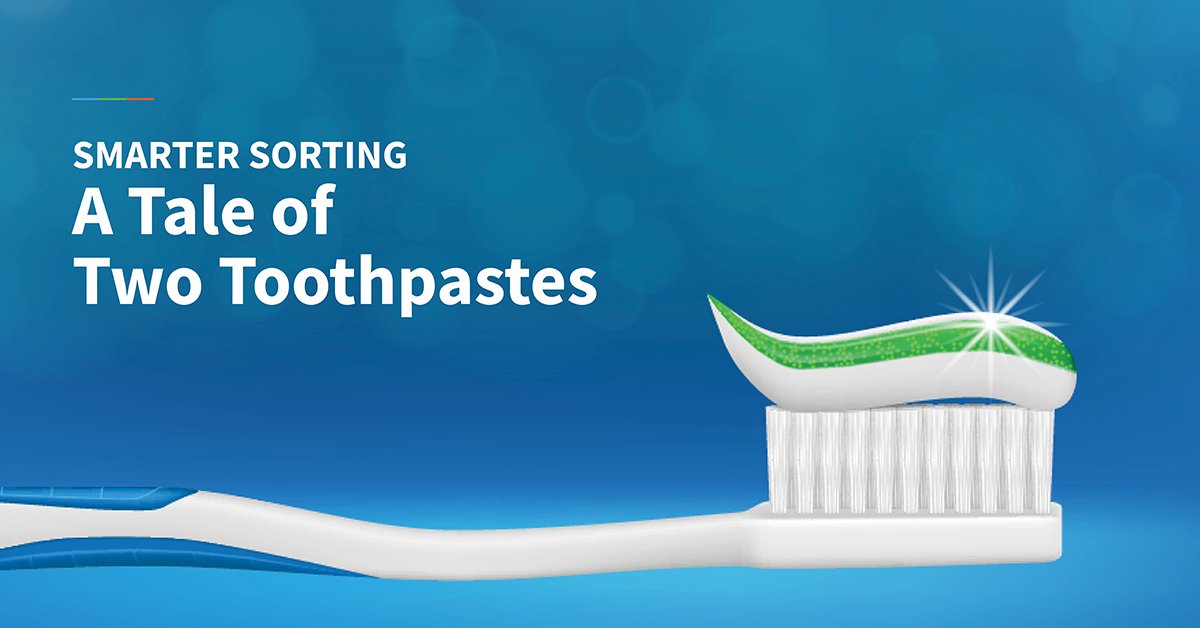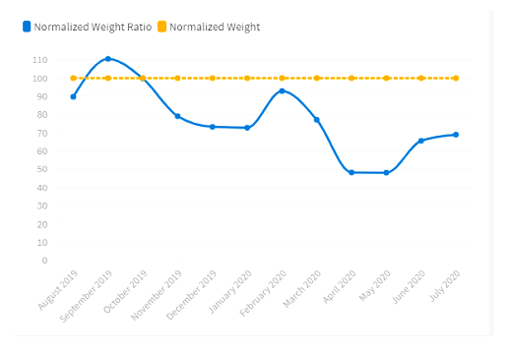
A Tale of Two Toothpastes (Or, Managing State Toxic Waste Disposal)
Working with a major retailer, Smarter Sorting’s automated waste classification has enabled a 47% reduction in State Toxic waste, saving time and money while helping the environment.
What happens to toothpaste when it is returned to your store? What is the cost – not only to your company, but also the environment – to manage a tube of toothpaste properly? How can one toothpaste be considered an expensive “toxic waste” while another nearly identical tube isn’t?
We’re going to dig into the nerdy minutiae of our world. A world of mysterious toxicology, arcane environmental statutes and the heroic employees embattled by these matters on an everyday basis. We’re going to bring to life the challenges faced by one of the world’s largest retailers and the enormous opportunities now made possible through Smarter Sorting.
But first, we must acknowledge that …
You went to the store and bought the wrong toothpaste…
Your partner is casting you that painfully familiar stare.
They’re not mad, just disappointed.
Dodging inquiries of “how do you not know which toothpaste they like?” you attempt to amend this egregious error.
You have three options.
You can:
1. Throw it away. Often the first thing that comes to mind. Terrible, yes, but out of sight and out of mind. It can’t be the best option though.
2. Return it to the store. Probably the smartest thing to do. You get your money back and your household can go back to using your tried and true brand.
3. Put your foot down and say “tough luck.” But this isn’t the hill you want to die on, so option #2 it is…
The Great “State Toxics” Bucket
So you’ve returned your toothpaste and the retailer has generously accepted it. To a consumer, the experience is one of mild inconvenience mixed with relief. Armed with the product and a receipt, you exchange them back to the store for money. Simple as that.
But what happens on the retailer side of things? Who’s taking the toothpaste – and where? What’s happening next? Do you always have so many questions?
The job of knowing what to do with your toothpaste – and the thousands of other products returned to Smarter Sorting’s retail partners each day – falls to a very special set of employees who work in the back of stores to manage customer returns, damaged items, donation programs, return-to-vendor programs … the list goes on.
These back-of-store staffers are a lynchpin in the daily operations of retail stores. They work tirelessly out of sight from consumers like you returning unwanted toothpaste. They handle all items that are returned by customers and all items that otherwise go unsold. It’s about 1 in 10 products, if you can believe it.
Among their responsibilities is managing items that must be handled as hazardous waste due to federal, state and local chemical regulatory requirements.
In the back of the store, there is a section dedicated to hazardous waste management. This is where items that can’t be returned to the vendor or donated get sorted into hazardous waste buckets – often bright colored containers, per the example we staged below at Smarter Sorting HQ. Each container represents a distinct set of hazardous criteria. Picking the correct bucket is critical for ensuring the most safe, sustainable, and cost effective decision is made.
Example Back of Store Area, as mocked up in Smarter Sorting’s Retail Lab

Items are sorted based on their hazards. Federal or RCRA hazards account for most of the hazardous waste buckets. Flammables, corrosive acids, corrosive bases, reactives, toxics – if RCRA regulates it, it’s sorted.
At every retailer, there’s usually one bucket for all the non-RCRA waste. A “State Toxics” drum for wastes that aren’t federally regulated but are considered toxic by certain ecologically minded states (Washington, for example). By and large, the State Toxics container usually contains the most waste by weight.
Allocation of Waste Streams (% of total) for a representative retailer

Knowing exactly what should and should not go into the State Toxic bucket is actually a very difficult task. To make it simple, many retailers call most non-federally-regulated chemicals state toxics in order to play it safe.
But what actually is a state toxic? Is toothpaste one of them?
A Tale Of Two Toothpastes
Close your eyes and imagine the toothpaste aisle.
Promises of whiter teeth, brighter teeth, cavity protection, plaque annihilation, better breath, a gentler experience, some benefit for your gums because teeth don’t have a monopoly on dental health.
We all know the array of benefits that are marketed to us. But let’s look at it through another lens – whether the chemicals in the toothpaste create expensive waste for retailers.
We selected two toothpastes that are sold in nearly identical boxes. They are sold by the same brand and they occupy more or less the same spot on the retail shelf. One promises whitening, the other cavity protection, but from 10 feet away you’d swear the boxes are the same.
But these near-identical toothpastes are starkly different should they become regulated waste.
Toothpaste #1 is a WT02 regulated waste in Washington.
Toothpaste #2 is not.
How is it that one of them is a regulated waste and one of them isn’t? Aren’t they both just toothpaste?
It all boils down to the toxicity of each ingredient in the products. To find the ingredient composition and make an accurate waste determination for Washington State, check out the product Safety Data Sheet, also known as an SDS.
For Toothpaste #1, we have the following information about the ingredients listed in the product’s Safety Data Sheet:

That’s a long list of chemicals, but there are four that really matter for Washington regulations:
- Tetrasodium pyrophosphate (Washington Toxic Category D)
- Sodium lauryl sulfate (C)
- Hydrogen peroxide (D)
- L-menthol (D)
All of these ingredients meet the listed toxicity thresholds for Washington State…

… And the cumulative concentration of these ingredients in this specific toothpaste is enough for the product to be considered a WT02 Washington State Toxic Waste*.
E.C. = (5% / 10000) + (5% / 1000) + (5% / 10000) + (5% / 10000)
E.C. = 0.0065%
(E.C. > 0.001%) AND (E.C. < 1.000%) = TRUE
∴ WT02 Waste
Toothpaste #2, however, has a different, less toxic, group of ingredients.

Carvone (CAS-No. 6485-40-1) is toxic according to Washington State, but there isn’t enough in this formulation to exceed the toxicity thresholds.
E.C. = (1% / 10000)
E.C. = 0.0001%
(E.C. > 0.001%) AND (E.C. < 1.000%) = FALSE
∴ NOT WT02 Waste
In plain English, this toothpaste is not regulated by the State of Washington.
An Expensive and Wasteful Problem
Why does it matter whether an item is considered a state toxic or not?
Hazardous items require tracking via waste manifests, and every ounce of waste is measured to ensure retailers properly manage EPA Generator Status, especially in Washington where state waste counts toward strict regulatory limits. Also, improper disposal of hazardous wastes by retailers can lead to hefty fines.
To be safe and avoid any regulatory trouble, retailers pay hazardous waste professionals to haul the waste products away. A pound of State Toxic waste can cost anywhere from 20 – 30 times more in disposal fees than a pound of non-hazardous waste. An unnecessary hazardous waste classification (as is often the case with State Toxics) leads to more expensive regulated waste.
So just how much toothpaste comes through the back of a store, either via returns or otherwise?
The answer…
A Lot of Toothpaste
Using high-fidelity tracking of our retail partners’ in- store operations, we can pinpoint the volume of materials finding their way into the back of the store.
Over the course of one year at 30 sample retail locations, we found that nearly 1,140 pounds were returned to the back of stores! That’s 38 lbs of toothpaste – or 148 tubes – per store, per year.
If you extrapolate that 148-tube/year rate across 750 retail stores – a reasonable assumption for a major retailer – that adds up to 28,497 pounds of toothpaste a year!
Thankfully, our retail partners have sterling donation programs that help local and national programs send valuable products to people who can put them to good use.
But if a given tube can’t be donated – say, because it’s damaged or leaking – the remainder doesn’t always need to become regulated waste.
For environmentally conscious retailers using Smarter Sorting, instantly receiving accurate state toxicity determinations has led to dramatic decreases in state toxic misclassifications.
And over the past year, Smarter Sorting has directly contributed to a 47% reduction in overall State Toxic waste across our retail partners. And we’re just getting started.
 Photo from smartersorting.com
Photo from smartersorting.com
CONCLUSION
Not every retailer faces the same challenges. For some, it’s managing the disposal of returned toothpaste in the most economical and sustainable way. For others, it may be ensuring the compliant shipping of electronic devices with lithium ion batteries or diverting cleaning supplies from their waste stream.
What are your unique compliance challenges? Reach out to us to learn how you can save time and money by drastically reducing your State Toxic waste. We look forward to hearing from you.
